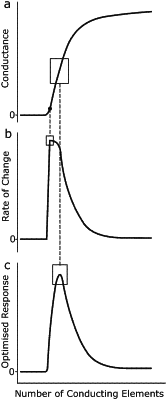| CPC G01N 27/126 (2013.01) [C08F 34/00 (2013.01); C09D 5/4407 (2013.01); C09D 5/4476 (2013.01)] | 18 Claims |

|
1. A process for producing a sensor component for detecting an analyte, the process comprising:
providing an insulating substrate disposed between a first electrode and a second electrode wherein a plurality of conductive nodes are disposed on a surface of the insulating substrate;
providing a monomer electrolyte solution, the monomer electrolyte solution comprising a plurality of monomer molecules capable of electrochemical growth to form a plurality of conducting polymer molecules;
electrochemically growing a plurality of conducting polymer molecules from the monomer electrolyte solution, the plurality of conducting polymer molecules being grown on a surface of the insulating substrate to electrically connect the first electrode to the second electrode, wherein at least some of the plurality of the conducting polymer molecules grown are bonded to one or more of the plurality of conductive nodes such that electrical junctions are formed by conducting polymer molecules grown on the surface of the insulating substrate between one or more of the conductive nodes and at least one of the first and second electrode, providing a percolation network that electrically connects the first electrode to the second electrode; the conducting polymer molecules being capable of displaying a change in an electrical property in response to interaction with an analyte; and
ceasing electrochemical growth of the conductive polymer molecules;
wherein cyclic voltammetry is not employed to grow the plurality of conducting polymer molecules.
|